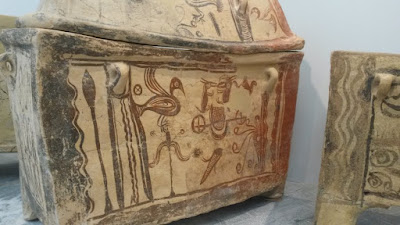The Late Minoan III period on Crete (ca. 1430-1100 BCE) was characterised by substantial socio-political discontinuity and island-wide change following the decline of the Minoan palaces. Alongside an array of other developments in material culture, the period was marked by a clear shift in mortuary practices, which included the expansion and re-invention of the pre-existing tradition of burial in clay funerary containers known as ‘larnakes’. Unlike funerary receptacles from earlier periods, many LM III larnakes were adorned with rich painted compositions. These drew upon a wide range of floral, faunal, cultic, and geometric motifs, many of which were already well-established in the Minoan iconographic traditions. Despite having received a great deal of scholarly attention, the exact symbolic significance of larnax decoration remains difficult to interpret, particularly given its typically abstract nature.
Jacob’s lecture investigates the value of a systematic ‘syntactic’ approach to larnax decoration as a means of establishing a more solid foundation for its iconographic interpretation. The identification and quantification of the specific symbolic associations and patterns characterising the use of individual larnax motifs may permit a more thorough understanding of the fundamental visual structures through which meaning was generated. A greater knowledge of this syntax can aid ongoing attempts to assess the possible funerary meanings associated with LM III art, as well as highlight in more detail the relationship between the sudden development of larnax iconography and the processes of socio-cultural change occurring on Crete during this period. In particular, an analysis of syntactic patterns can assist in demonstrating how familiar Minoan symbols - for example the horns of consecration and double axe - were adapted to serve new mortuary functions as larnax adornments, and the extent to which this use is consistent with that of both earlier and other contemporary artistic contexts.
We invite you to attend Jacob’s lecture at 19:30 on the 2nd to learn more about how a Minoan funerary container type was transformed in the 13th and 12th centuries BCE and decorated with large-scale external and internal painting.
Cordially,
David Rupp
Director




No comments:
Post a Comment